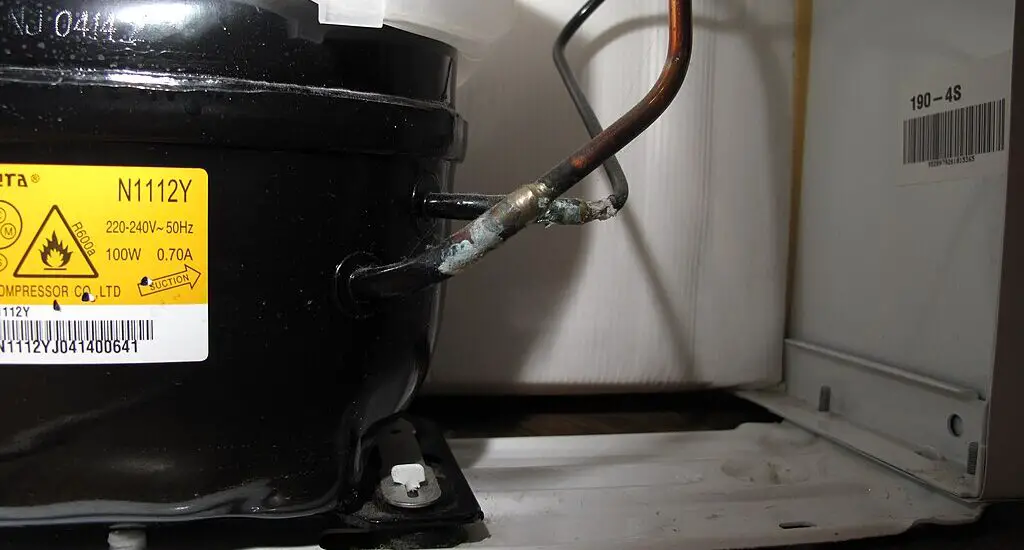If your refrigerator compressor clicks but won’t turn on, this article will walk you through each step to troubleshoot this problem comprehensively.

What You’ll Need
Screwdriver: For removing any covers or screws.
Multimeter: To check the electrical components for continuity.
You can get this AstroAI Multimeter Tester from Amazon now.
Replacement parts: These could include a new start relay or capacitor, depending on what you find.
Steps to Resolve the ‘Refrigerator Compressor Clicks But Won’t Turn On’ Problem
The steps below will guide you on how to resolve the “Refrigerator compressor clicks but won’t turn on” problem.
Step 1: Unplug Your Refrigerator
Before you start poking around electrical components, it’s crucial for your safety to unplug the refrigerator. This will eliminate the risk of electric shock while you troubleshoot.
Step 2: Locate the Compressor
You will usually find the compressor at the back or bottom of the refrigerator. Look for a large, cylindrical, or boxy metal object. If there are any protective covers or casing held by screws, use your screwdriver to remove them and gain access to the compressor.
Step 3: Inspect the Start Relay
The start relay plays a crucial role in helping the compressor start-up. It’s a small device that you’ll find plugged into the side of the compressor. The start relay assists the compressor by providing it with the initial boost of power it needs to start running. If the relay is faulty, the compressor may click but won’t turn on.
How to Test the Start Relay with a Multimeter
To determine if your start relay is working correctly, you’ll need a multimeter. A multimeter is a device that measures electrical properties like voltage, current, and resistance.
Set your multimeter to the lowest setting for resistance, typically denoted by the “Ω” symbol.
Place the multimeter probes onto the two terminals of the start relay. These are usually metallic and may be labeled.
Check the reading on the multimeter. A functioning relay will typically show a resistance between 3 and 12 ohms. If the multimeter shows a reading of zero or a reading that is infinite, the relay is likely faulty.
What to Do If the Start Relay is Faulty
If your start relay is defective, it will need to be replaced. You can purchase a replacement part from a trusted vendor and usually snap it into place yourself, although professional installation is advised if you are unfamiliar with electrical components.
Step 4: Check the Capacitor
The capacitor is another vital component that works in tandem with the start relay to help the compressor start. The capacitor stores electrical energy and releases it when the compressor needs to start, providing an additional power boost.
How to Test the Capacitor with a Multimeter
You will also use your multimeter to test the capacitor.
First, set the multimeter to the capacitance setting, often labeled as “CAP” or “μF”.
Touch the multimeter probes to the capacitor terminals. Be careful not to touch the probes to each other as this will produce a false reading.
Check the reading. A healthy capacitor should have a capacitance value within 10% of the value labeled on the capacitor. If the reading is outside this range, it’s likely that the capacitor is faulty.
What to Do If the Capacitor is Faulty
If you determine that the capacitor is defective, you’ll need to replace it. Replacement capacitors can be bought from trusted vendors. Installation typically involves snapping the new capacitor into place, although professional installation is recommended if you’re not comfortable with handling electrical components.
Step 5: Assess the Compressor Itself
If both the start relay and the capacitor appear to be functioning correctly, it’s time to consider that the compressor itself might be the issue. Compressors are intricate devices and are usually sealed units, making them difficult to repair yourself.
Check out these other articles…
Short Cycling of Refrigeration Compressor: Proven solutions
Refrigerator Compressor Always On: 4 Causes & Sure Fixes
Refrigerator Compressor Auto Cut Off: Your Ultimate Guide
Refrigerator Compressor Burnout: Identification & Solutions
Refrigerator Compressor Buzzing Not Cooling: DIY Fix Guide
When to Call a Professional
If you’ve reached this step and your compressor still clicks but won’t turn on, it’s time to call a qualified technician for a comprehensive assessment. They have the specialized equipment and knowledge to accurately diagnose and safely repair or replace a faulty compressor.